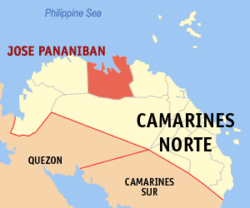
Back Jose Panganiban, Camarines Norte BCL Jose Panganiban, Camarines Norte CBK-ZAM Jose Panganiban, Camarines Norte CEB Jose Panganiban German José Panganiban Spanish Jose Panganiban French Jose Panganiban, Camarines Norte GOR Jose Panganiban, Camarines Utara ID Jose Panganiban, Camarines Norte ILO Jose Panganiban Italian
Jose Panganiban
Mambulao | |
|---|---|
| Municipality of Jose Panganiban | |
 View from the mountain | |
| Motto: Alay sa Diyos at sa Bayan | |
| Anthem: Mahal Kong Jose Panganiban (Mambulao Hymn) | |
 Map of Camarines Norte with Jose Panganiban highlighted | |
Location within the Philippines | |
| Coordinates: 14°17′32″N 122°41′34″E / 14.2922°N 122.6928°E | |
| Country | Philippines |
| Region | Bicol Region |
| Province | Camarines Norte |
| District | 1st district |
| Founded | 1634 |
| Renamed | December 1, 1934 |
| Named for | Jose Maria Panganiban |
| Barangays | 27 (see Barangays) |
| Government | |
| • Type | Sangguniang Bayan |
| • Mayor | Ariel M. Non |
| • Vice Mayor | Casimero B. Padilla, Jr. |
| • Representative | Josefina B. Tallado |
| • Municipal Council | Members |
| • Electorate | 36,627 voters (2022) |
| Area | |
• Total | 214.44 km2 (82.80 sq mi) |
| Elevation | 43 m (141 ft) |
| Highest elevation | 277 m (909 ft) |
| Lowest elevation | 0 m (0 ft) |
| Population (2020 census)[3] | |
• Total | 63,662 |
| • Density | 300/km2 (770/sq mi) |
| • Households | 14,560 |
| Economy | |
| • Income class | 2nd municipal income class |
| • Poverty incidence | 26.38 |
| • Revenue | ₱ 205.2 million (2020) |
| • Assets | ₱ 456 million (2020) |
| • Expenditure | ₱ 130.9 million (2020) |
| • Liabilities | ₱ 149.7 million (2020) |
| Service provider | |
| • Electricity | Camarines Norte Electric Cooperative (CANORECO) |
| Time zone | UTC+8 (PST) |
| ZIP code | 4606 |
| PSGC | |
| IDD : area code | +63 (0)54 |
| Native languages | Tagalog |
| Website | mambulao |
Jose Panganiban, officially the Municipality of Jose Panganiban (Tagalog: Bayan ng Jose Panganiban), is a municipality in the province of Camarines Norte, Philippines. According to the 2020 census, it has a population of 63,662 people.[3]
- ^ Municipality of Jose Panganiban | (DILG)
- ^ "2015 Census of Population, Report No. 3 – Population, Land Area, and Population Density" (PDF). Philippine Statistics Authority. Quezon City, Philippines. August 2016. ISSN 0117-1453. Archived (PDF) from the original on May 25, 2021. Retrieved July 16, 2021.
- ^ a b Census of Population (2020). "Region V (Bicol Region)". Total Population by Province, City, Municipality and Barangay. Philippine Statistics Authority. Retrieved July 8, 2021.
- ^ "PSA Releases the 2021 City and Municipal Level Poverty Estimates". Philippine Statistics Authority. April 2, 2024. Retrieved April 28, 2024.



